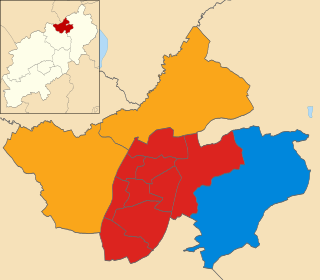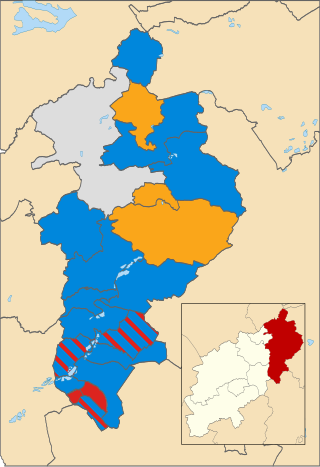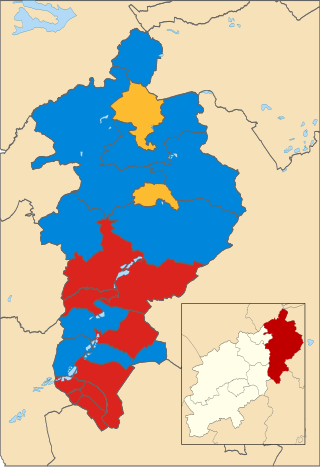East Northamptonshire District Council in Northamptonshire, England was elected every four years. After the last boundary changes in 2007, 40 councillors were elected from 22 wards. The district was abolished in 2021, with the area becoming part of North Northamptonshire.
Elections to East Ayrshire Council were held on 1 May 2003, the same day as the 31 other local government elections in Scotland and elections to the Scottish Parliament. This was the third election since the council's creation in 1995 and the last election to use first-past-the-post voting.

The 2015 United Kingdom local elections were held on Thursday 7 May 2015, the same day as the general election for the House of Commons of the United Kingdom.

The 1976 Corby District Council election took place on 6 May 1976 to elect members of Corby District Council in Northamptonshire, England. This was on the same day as other local elections. It was the first election be held under new ward boundaries. The Conservative Party gained overall control of the council from the Labour Party, for the first and only time in its history.

The 1979 Corby District Council election took place on 3 May 1979 to elect members of Corby District Council in Northamptonshire, England. This was on the same day as other local elections. The Labour Party regained overall control of the council which it had lost to the Conservative Party at the previous election in 1976. The council has remained continuously under Labour control to this day.

The 1983 Corby District Council election took place on 5 May 1983 to elect members of Corby District Council in Northamptonshire, England. This was on the same day as other local elections. The Labour Party retained overall control of the council, which it had gained at the previous election in 1979.

The 1991 Corby District Council election took place on 2 May 1991 to elect members of Corby District Council in Northamptonshire, England. This was on the same day as other local elections. The Labour Party retained overall control of the council, which it had held since 1979.

The 1995 Corby District Council election took place on 4 May 1995 to elect members of Corby Borough Council in Northamptonshire, England. This was on the same day as other local elections. The Labour Party retained overall control of the council, which it had held continuously since 1979.

The 1979 East Northamptonshire District Council election took place on 3 May 1979 to elect members of East Northamptonshire District Council in Northamptonshire, England. This was on the same day as the 1979 General Election and other local elections. This was the first election to be held under new ward boundaries. The Conservative Party retained overall control of the council which it had held since the council's creation in 1973.

The 1983 East Northamptonshire District Council election took place on 5 May 1983 to elect members of East Northamptonshire District Council in Northamptonshire, England. This was on the same day as other local elections. The Conservative Party retained overall control of the council which it had held since the council's creation in 1973.

The 1987 East Northamptonshire District Council election took place on 7 May 1987 to elect members of East Northamptonshire District Council in Northamptonshire, England. This was on the same day as other local elections. The Conservative Party retained overall control of the council which it had held since the council's creation in 1973.

The 1991 East Northamptonshire District Council election took place on 2 May 1991 to elect members of East Northamptonshire District Council in Northamptonshire, England. This was on the same day as other local elections. This was the first election to be held under new ward boundaries. The Conservative Party retained overall control of the council which it had held since the council's creation in 1973.

The 1995 East Northamptonshire District Council election took place on 2 May 1995 to elect members of East Northamptonshire District Council in Northamptonshire, England. This was on the same day as other local elections. This was the first election to be held under new ward boundaries. The Labour Party gained overall control of the council for the first and only time in the council's history.

The 2003 East Northamptonshire District Council election took place on 1 May 2003 to elect members of East Northamptonshire District Council in Northamptonshire, England. This was the first election to be held under new ward boundaries. The Conservative Party retained overall control of the council.

The 2007 East Northamptonshire District Council election took place on 3 May 2007 to elect members of East Northamptonshire District Council in Northamptonshire, England. This was on the same day as other local elections. This was the first election to be held under new ward boundaries. The Conservative Party retained overall control of the council, while the Labour Party was wiped out, with a single Independent councillor providing the sole opposition.

The 2011 East Northamptonshire District Council election took place on 5 May 2011 to elect members of East Northamptonshire District Council in Northamptonshire, England. This was the first election to be held under new ward boundaries. The Conservative Party retained overall control of the council.

The 1995 Bath and North East Somerset Council election was held on Thursday 4 May 1995 to elect councillors to the new Bath and North East Somerset Council in England. It took place on the same day as other district council elections in the United Kingdom.
Elections to East Ayrshire Council were held on 6 May 1999, alongside elections to the Scottish Parliament. This was the second election following the local government reforms in 1994 and the first following the Third Statutory Reviews of Electoral Arrangements which resulted in two additional seats from the previous election.
Dalmellington was one of 32 electoral wards of East Ayrshire Council. Originally created in 1974, the ward was initially within Cumnock and Doon Valley District Council before the local government reforms in the 1990s. The ward elected one councillor using the first-past-the-post voting electoral system.
Auchinleck was one of 32 electoral wards of East Ayrshire Council. Originally created in 1974, the ward was initially within Cumnock and Doon Valley District Council before it was abolished in 1984. Following the local government reforms in the 1990s, the ward was reestablished in 1999 as part of East Ayrshire. The ward elected one councillor using the first-past-the-post voting electoral system.















